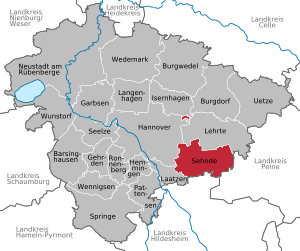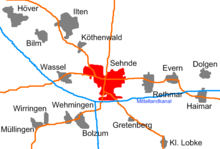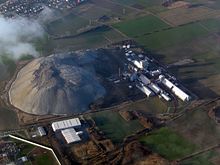Sighted
| coat of arms | Germany map | |
|---|---|---|

|
Coordinates: 52 ° 19 ′ N , 9 ° 58 ′ E |
|
| Basic data | ||
| State : | Lower Saxony | |
| County : | Hanover region | |
| Height : | 53 m above sea level NHN | |
| Area : | 103.39 km 2 | |
| Residents: | 23,384 (Dec. 31, 2019) | |
| Population density : | 226 inhabitants per km 2 | |
| Postal code : | 31319 | |
| Primaries : | 05138, 05132 | |
| License plate : | H | |
| Community key : | 03 2 41 016 | |
| LOCODE : | DE SNE | |
| City structure: | 15 districts | |
City administration address : |
Nordstrasse 21 31319 Sehnde |
|
| Website : | ||
| Mayor : | Olaf Kruse ( SPD ) | |
| Location of the city of Sehnde in the Hanover region | ||
Sehnde is a town (since October 18, 1997) and an independent municipality in Lower Saxony on the south-eastern edge of the Hanover region . It consists of 15 districts with around 24,000 inhabitants.
geography
Sehnde borders in a clockwise direction, starting in the southwest, with Laatzen , Hanover and Lehrte as well as Hohenhameln ( Peine district ) and Algermissen ( Hildesheim district ).
history
Prehistory and early history
The area of today's city of Sehnde was already settled during the Iron Age in the 1st millennium BC. BC to the Migration Period in the 5th or 6th century, although it is not known whether the settlement was continuous.
Archaeological finds and findings from this period originate from excavations in 2017 during the development of a new building area around one kilometer north of the town center. These include the remains of pit houses and post marks from smaller storage structures as well as remnants of racing furnaces and slag from iron smelting. The ceramic shards found in the garbage pits made it possible to date the settlement period.
middle Ages
Around 800 the area around Sehnde was settled by Franconian military colonists. The first written mention of the place name Sehnde comes from the year 1147. After several armed conflicts, the area was divided between the Brunswick-Lüneburg Guelphs and the Hildesheim monastery. During this time, ten Sehnder districts belonged to the Großer Free and thus since 1885 to the Burgdorf district , while the remaining five belonged to the Hanover (Müllingen, Wassel) and Hildesheim (Bolzum, Wehmingen, Wirringen) districts.
Due to the historical affiliation to several manors, today's Sehnder districts were divided into the three administrative districts of Lüneburg , Hanover and Hildesheim until the Lower Saxony regional reform in the 1970s . Until December 31, 2004, Sehnde belonged to the then administrative district of Hanover, which, like all of Lower Saxony's administrative districts, was dissolved.
New parish Sehnde
The territorial reform, which came into effect on March 1, 1974, created the new municipality from the 15 previously independent municipalities Bilm , Bolzum , Dolgen , Evern , Gretenberg , Haimar , Höver , Ilten , Klein Lobke , Müllingen , Rethmar , Sehnde, Wassel , Wehmingen and wering .
Population development
(on June 6, 1961, on May 27, 1970 census results, each with the locations incorporated later, from 1998 on each December 31)
- 1961 - 18,223
- 1970 - 18,524
- 1998 - 19,787
- 1999 - 20,241
- 2000 - 20,759
- 2001 - 21,123
- 2002 - 21,543
- 2003 - 21,902
- 2004 - 22,198
- 2005 - 22,759
- 2010 - 23,497
- 2014 - 24.202
- 2015 - 23,489
- 2016 - 23,584
- 2017 - 23,505

religion
The Evangelical Lutheran community of Sehnde belongs to the Burgdorf parish . The historic Kreuzkirche on the southern edge of the former village center belongs to it in Sehnde . The Bonhoeffer House with church hall and community rooms, built in 1963 on Papenholz, was abandoned in 2012 and sold to the city. The Catholic parish of St. Maria is part of the Hannover deanery . It has the church of the same name from 1955 on Papenholz. The Evangelical Free Church Sehnde has its building on Steinweg, until 2006 the New Apostolic Congregation Sehnde was located here . The nearest New Apostolic Church is today eight kilometers away in Lehrte . The Sehnde Bible Congregation holds its services in the urban meeting place. The Jehovah's Witnesses have a conference venue in Sehnde. Other churches are located in the other districts.
politics
The council of the city of Sehnde has 33 councilors. The AfD won four seats in the local elections on September 11, 2016, but only had three candidates on the list of candidates. Therefore, the 34th seat remains vacant. The full-time mayor is also a member of the council, but does not belong to any parliamentary group, regardless of party affiliation .
The council is composed as follows:
| CDU | SPD | AfD | Green | The left | FDP | total |
|---|---|---|---|---|---|---|
| 13 seats | 12 seats | 3 seats | 3 seats | 1 seat | 1 seat | 33 seats |
Culture and sights
The Regional Museum Sehnde is located in the district of Rethmar , supported by the Association Regional Museum Sehnde e. V. The district of Wehmingen houses the Hanover tram museum , supported by the association of the same name, which is located on the site of the former Hohenfels potash mine. The cultural association Sehnde e. V. offers monthly cultural events, among others from the field of theater and literature.
The core town of Sehnde (for the districts see there) is characterized by some characteristic buildings:
- Evangelical Church of the Holy Cross , Romanesque tower, baroque nave
- Catholic parish church St. Maria , 1955, simple hall church
- Town hall, 1976, with carillon
- Kugelbake at the canal sports harbor, reduced copy of the Cuxhaven sea mark
- KGS Sehnde , at the B 65, school with approx. 1950 students and over 130 teachers
On the Mittelland Canal
Architectural monuments
Economy and Infrastructure
The ceramic smelter in Sehnde produced masonry bricks from around 1900 until it was closed in 1982 . The districts of today's town of Sehnde were and are characterized by agriculture, with most of the districts being transformed into housing developments since the 1970s through new development areas. In 2004, the Sehnde correctional facility was opened, which further increased the population.
Potash mining was the most important branch of industry for many decades . The first potash mine was sunk in Wehmingen from 1896 on what is now known as the Hohenfels site , and mining began in 1902. Production here was shut down as early as 1927; in the core town of Sehnde and in the district of Ilten , however, potash was promoted for fertilizer and road salt production until the 1990s. An affiliated fertilizer and road salt factory is still in operation.
Potash works
The Hohenfels potash plant was shut down in 1982. The mine workings were filled with stockpile liquor from the Friedrichshall dump between 1984 and 1992. The Friedrichshall potash plant was in operation from 1905 to 1981. The mine field was operated by Kali Chemie AG until 1981 , then taken over by K + S AG and continued in operation until 1994. Only fertilizers were produced. The Hugo potash plant in Ilten was part of the Bergmannssegen-Hugo composite mine. After the production was shut down at the end of 1994, potash fertilizer will continue to be produced in the plant from delivered raw materials. The pit is currently being flooded with brine and fresh water.
In addition to other smaller industrial companies, there was a sugar factory in Sehnde until 1987 and there is still a cement factory in Höver today .
traffic
Federal highways 65 and 443 cross in Sehnde . The nearby federal motorways 2 and 7 as well as the B 6 ( Messeschnellweg ) can be reached via them .
Sehnde is on the Lehrte – Hildesheim railway line . Since 2008, the Hanover S-Bahn has been offering hourly connections via Lehrte to Hanover Central Station and via Algermissen to Hildesheim Central Station . In addition, Üstra bus lines and a regional bus line open up the city.
At the city port of Sehnde , the Mittelland Canal branches off to the Hildesheim branch canal to the south. The Bolzum lock is located in the Bolzum district .
Personalities
- Georg Wilhelm Friedrich Beneken (1765–1824), clergyman, philosopher and publicist, born in Sehnde
- Herbert Freiherr von Ohlen and Adlerscron (1895–1958), officer and agricultural functionary, from 1945 to 1950 managing director of the Sugar Industry Association in Sehnde
- August Tünnermann (1896–1982), politician (KPD), died in Sehnde
- Rudi Milatz (1903–1979), crop scientist , died in Sehnde
- Julius Brumsack (1915–2011), merchant and Holocaust survivor, spent his youth in Sehnde
- Gisela Fischer (* 1938), doctor and university professor, practiced as a general practitioner in Sehnde
- Dieter Warnecke (1956–2019), Lieutenant General of the Army of the Bundeswehr, born in Sehnde
- Dirk Dettmar (* 1957), criminal and artist, imprisoned in the Sehnde prison since 2005
- Peter Gerloff (* 1957), Roman Catholic priest, from 2004 to 2013 parish pastor of St. Maria in Sehnde
- Thomas Sonar (* 1958), mathematician, born in Sehnde
- Ursula von der Leyen (* 1958), politician (CDU), President of the European Commission from November 1, 2019 , was a member of the city council of Sehnde and chairwoman of the CDU parliamentary group from 2001 to 2004
- Birgit Honé (* 1960), politician (SPD) and state minister, lives in Sehnde
- Silke Lesemann (* 1962), politician (SPD), member of the state parliament for constituency 29 (Laatzen, Pattensen, Sehnde)
- Christoph Dreyer (* 1966), politician (CDU), member of the state parliament for constituency 29 (Laatzen, Pattensen, Sehnde)
- Michael Thiede (* 1981), handball player, spent his childhood in Sehnde
- Gregor Rohmann (* 1970), historian, spent his childhood and youth in Sehnde
literature
- Adolf Meyer: Sehnde - From farming village to industrial community. Edited by the municipality of Sehnde, 1975.
- Wolfgang Leonhardt , Ludwig Meyer: Ortssippenbuch Sehnde-Gretenberg 1585-1900. In: Dt. Ortssippenbücher, series B, vol. 170. Hannover 1998.
- City of Sehnde: Sehnde - very close outside. BVB-Verlagsgesellschaft mbH, Nordhorn 2003.
- Werner Walkling: Sehnde, O. T. Rethmar: Familienbuch Rethmar, 1686–1908. Hanover 2006.
- Werner Walkling: Sehnde, O. T. Haimar, Evern, Dolgen: Haimar family book, 1679–1915. Hanover 2014.
Web links
Individual evidence
- ↑ State Office for Statistics Lower Saxony, LSN-Online regional database, Table 12411: Update of the population, as of December 31, 2019 ( help ).
- ↑ Even in the Iron Age, the Kleine Öhr was a "building area" at hannover.de on October 25, 2017
- ↑ Excavator drivers discover Iron Age races in Hannoversche Allgemeine Zeitung from May 4, 2017
- ↑ A "building area" as early as the Iron Age
- ↑ Kleines Öhr was already settled in the Iron Age in Hannoversche Allgemeine Zeitung of October 26, 2017
- ↑ a b Federal Statistical Office (ed.): Historical municipality register for the Federal Republic of Germany. Name, border and key number changes in municipalities, counties and administrative districts from May 27, 1970 to December 31, 1982 . W. Kohlhammer GmbH, Stuttgart / Mainz 1983, ISBN 3-17-003263-1 , p. 223 .












